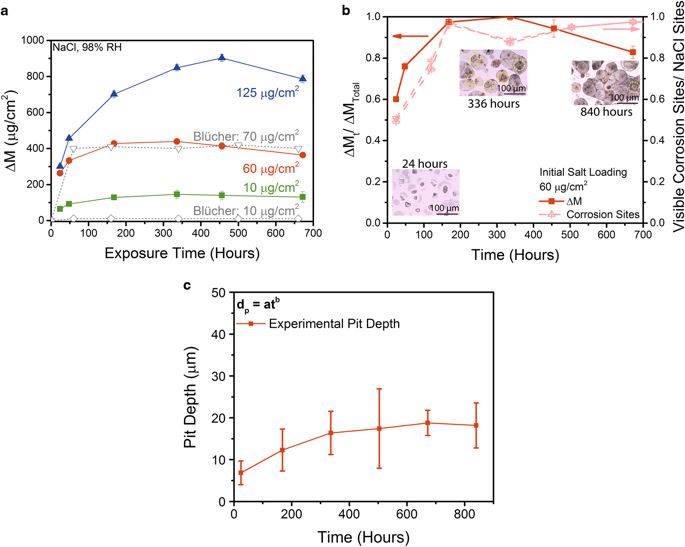npj Materials Degradation ( IF 5.1 ) Pub Date : 2017-11-14 , DOI: 10.1038/s41529-017-0020-3 Rebecca F. Schaller , Carlos F. Jove-Colon , Jason M. Taylor , Eric J. Schindelholz

|
Aluminum and aluminum alloys are widely used in many outdoor applications due to their inherent corrosion resistance attributed to the formation of a protective oxide layer. While corrosion rates are generally considered low for aluminum in many atmospheric environments, understanding of the corrosion performance over time is necessary to predict the cost, safety, and esthetics of these materials. The vast majority of the knowledgebase of atmospheric aluminum corrosion is built on environment–response relationships; often based on statistical correlation of corrosion rate data with atmospheric environmental conditions. However, there is still a limited mechanistic understanding of corrosion processes associated with this linkage. This lack in knowledge prevents interpretation and limits the extrapolation of these statistical datasets for prediction purposes. Here, the mechanistic dependence of aluminum corrosion rate on salt loading is explored through complimentary experimental and theoretical analysis relating corrosion rate to electrolyte chemistry, volume and corrosion products. From these results a reaction pathway is proposed for the atmospheric corrosion of aluminum that accounts for the governing effects of CO2 and salt loading on corrosion rate. This reaction pathway provides a new perspective that highlights the importance of the formation and growth of dawsonite (NaAlCO3(OH)2), and the subsequent gettering of sodium from the electrolyte leading to the stifling of corrosion kinetics. This study highlights the importance of accounting for the dynamic physical and chemical state of the electrolyte during corrosion in process models and measurement techniques to better understand and predict atmospheric corrosion behavior.
中文翻译:

碳酸钠和碳酸钠对铝大气腐蚀速率的控制作用
铝和铝合金由于形成保护性氧化物层而具有固有的耐腐蚀性,因此被广泛用于许多户外应用中。尽管通常认为铝在许多大气环境中的腐蚀速率很低,但是必须了解随时间的腐蚀性能,才能预测这些材料的成本,安全性和美观性。大气铝腐蚀的知识库中的绝大多数建立在环境与响应之间的关系上。通常基于腐蚀速率数据与大气环境条件的统计相关性。但是,对于与该连接相关的腐蚀过程的机理仍知之甚少。知识的缺乏阻止了解释,并限制了这些统计数据集的外推以用于预测目的。在此,通过将腐蚀速率与电解质化学性质,体积和腐蚀产物相关联的补充实验和理论分析,探索了铝腐蚀速率对盐负荷的机理依赖性。根据这些结果,提出了铝的大气腐蚀的反应途径,这解释了CO的控制作用。2,加盐量对腐蚀速度的影响。该反应途径提供了一个新的观点,突出了片钠铝石(NaAlCO 3(OH)2)的形成和生长的重要性,以及随后钠从电解液中吸出从而导致腐蚀动力学受阻的重要性。这项研究强调了在过程模型和测量技术中考虑腐蚀过程中电解质的动态物理和化学状态以更好地理解和预测大气腐蚀行为的重要性。



























 京公网安备 11010802027423号
京公网安备 11010802027423号